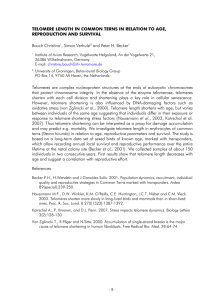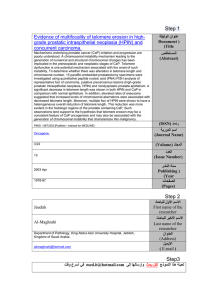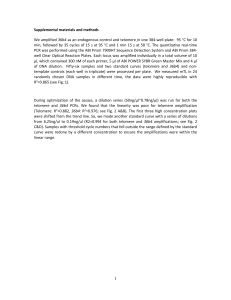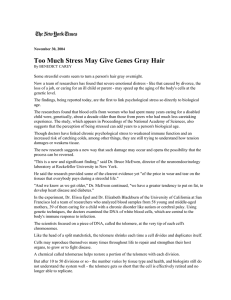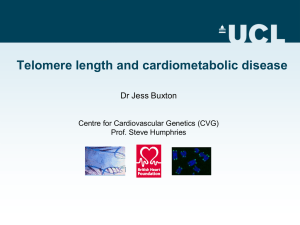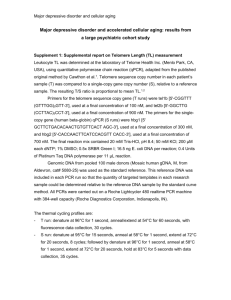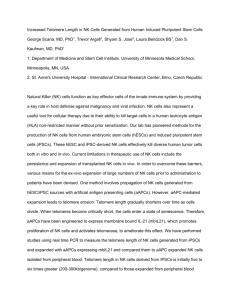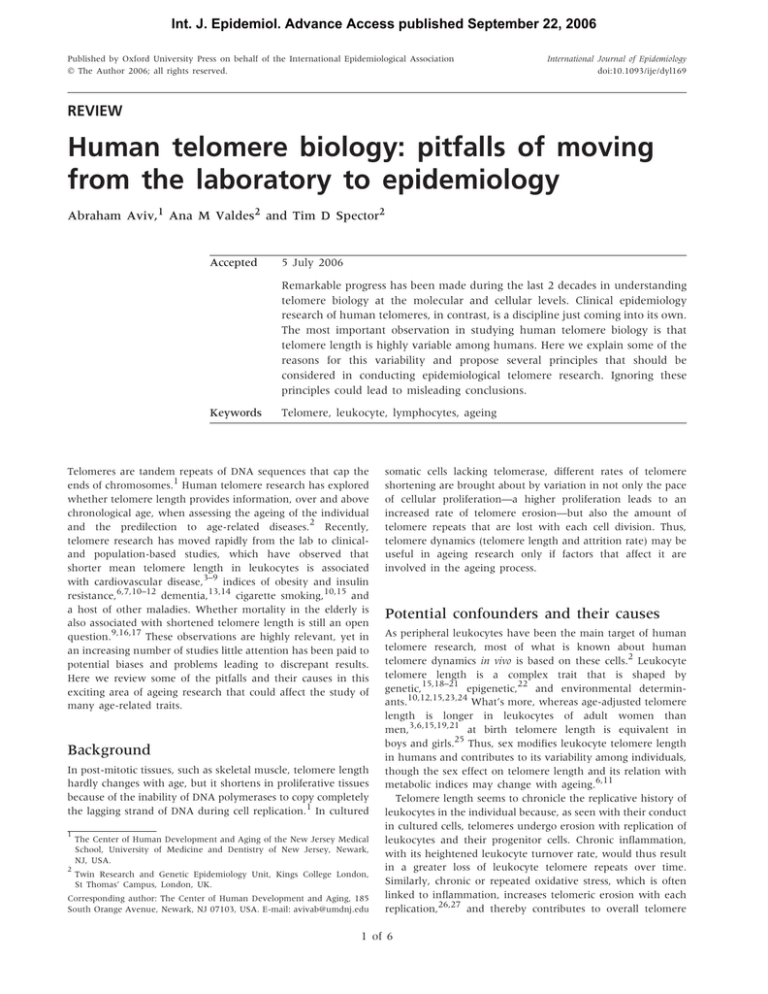
Int. J. Epidemiol. Advance Access published September 22, 2006
Published by Oxford University Press on behalf of the International Epidemiological Association
The Author 2006; all rights reserved.
International Journal of Epidemiology
doi:10.1093/ije/dyl169
REVIEW
Human telomere biology: pitfalls of moving
from the laboratory to epidemiology
Abraham Aviv,1 Ana M Valdes2 and Tim D Spector2
Accepted
5 July 2006
Remarkable progress has been made during the last 2 decades in understanding
telomere biology at the molecular and cellular levels. Clinical epidemiology
research of human telomeres, in contrast, is a discipline just coming into its own.
The most important observation in studying human telomere biology is that
telomere length is highly variable among humans. Here we explain some of the
reasons for this variability and propose several principles that should be
considered in conducting epidemiological telomere research. Ignoring these
principles could lead to misleading conclusions.
Keywords
Telomere, leukocyte, lymphocytes, ageing
Telomeres are tandem repeats of DNA sequences that cap the
ends of chromosomes.1 Human telomere research has explored
whether telomere length provides information, over and above
chronological age, when assessing the ageing of the individual
and the predilection to age-related diseases.2 Recently,
telomere research has moved rapidly from the lab to clinicaland population-based studies, which have observed that
shorter mean telomere length in leukocytes is associated
with cardiovascular disease,3–9 indices of obesity and insulin
resistance,6,7,10–12 dementia,13,14 cigarette smoking,10,15 and
a host of other maladies. Whether mortality in the elderly is
also associated with shortened telomere length is still an open
question.9,16,17 These observations are highly relevant, yet in
an increasing number of studies little attention has been paid to
potential biases and problems leading to discrepant results.
Here we review some of the pitfalls and their causes in this
exciting area of ageing research that could affect the study of
many age-related traits.
Background
In post-mitotic tissues, such as skeletal muscle, telomere length
hardly changes with age, but it shortens in proliferative tissues
because of the inability of DNA polymerases to copy completely
the lagging strand of DNA during cell replication.1 In cultured
1
2
The Center of Human Development and Aging of the New Jersey Medical
School, University of Medicine and Dentistry of New Jersey, Newark,
NJ, USA.
Twin Research and Genetic Epidemiology Unit, Kings College London,
St Thomas’ Campus, London, UK.
Corresponding author: The Center of Human Development and Aging, 185
South Orange Avenue, Newark, NJ 07103, USA. E-mail: avivab@umdnj.edu
somatic cells lacking telomerase, different rates of telomere
shortening are brought about by variation in not only the pace
of cellular proliferation—a higher proliferation leads to an
increased rate of telomere erosion—but also the amount of
telomere repeats that are lost with each cell division. Thus,
telomere dynamics (telomere length and attrition rate) may be
useful in ageing research only if factors that affect it are
involved in the ageing process.
Potential confounders and their causes
As peripheral leukocytes have been the main target of human
telomere research, most of what is known about human
telomere dynamics in vivo is based on these cells.2 Leukocyte
telomere length is a complex trait that is shaped by
genetic,15,18–21 epigenetic,22 and environmental determinants.10,12,15,23,24 What’s more, whereas age-adjusted telomere
length is longer in leukocytes of adult women than
men,3,6,15,19,21 at birth telomere length is equivalent in
boys and girls.25 Thus, sex modifies leukocyte telomere length
in humans and contributes to its variability among individuals,
though the sex effect on telomere length and its relation with
metabolic indices may change with ageing.6,11
Telomere length seems to chronicle the replicative history of
leukocytes in the individual because, as seen with their conduct
in cultured cells, telomeres undergo erosion with replication of
leukocytes and their progenitor cells. Chronic inflammation,
with its heightened leukocyte turnover rate, would thus result
in a greater loss of leukocyte telomere repeats over time.
Similarly, chronic or repeated oxidative stress, which is often
linked to inflammation, increases telomeric erosion with each
replication,26,27 and thereby contributes to overall telomere
1 of 6
2 of 6
INTERNATIONAL JOURNAL OF EPIDEMIOLOGY
shortening. Accordingly, age-adjusted telomere length in
leukocytes may be associated with diseases or environmental
factors linked to chronic increases in oxidative stress and
inflammation.6–12,15,23 However, chronic inflammatory states
and infections that are not considered to be strictly linked to
ageing also may display short leukocyte telomere length.
Subjects with these conditions should be considered for
exclusion from studies that chart leukocyte telomere dynamics
with a view to explore the biology and epidemiology of human
ageing. Yet these conditions underscore the tenet that inflammation and oxidative stress are determinant in leukocyte
telomere dynamics in vivo. For instance, leukocyte telomere
length is relatively short in systemic lupus erythematosus28 and
rheumatoid arthritis.29 Patients with these diseases are highly
prone to cardiovascular diseases,30,31 which are associated with
short leukocyte telomeres.3–9 In HIV, subsets of leukocytes,
CD81 T lymphocytes, in particular, show not only shorter
telomeres but also evidence of replicative impasse,32–34 evidently due to chronic viral antigen-driven proliferation. Further,
cigarette smoke increases oxidative stress and inflammation35–38
and smokers exhibit shortened leukocyte telomere length.10,15
Sample sizes and power considerations
The inter-individual variation in leukocyte telomere length at
birth and the effects of genetic factors, sex, inflammation, and
the environment on telomere attrition give rise to considerable
variation in age-adjusted leukocyte telomere length throughout
life. It follows that large numbers of subjects are required in
cross-sectional analyses to uncover potential links between
telomere parameters and ageing-related diseases.
Consider a cross-sectional study that wishes to infer
differences in telomere erosion where one models telomere
Table 1 Minimum sample size required for the telomere attrition
rate (b), expressed in bp/yr, to be significantly greater than zero
Age range
studied
(in yr)
Corresponding
sampling variance
2 a
in age (sa )
Min sample size for
b—95% CI . 0.01 bp/yr
20 bp/yr
30 bp/yr
40 bp/yr
5
2.1
2265
2060
578
10
7.9
584
262
149
20
30.3
155
73
41
30
63.4
76
35
21
40
102.3
48
23
15
50
140.9
35
18
12
60
170.9
30
15
10
a
Estimated in the TwinsUK cohort.
length as a linear function of age. The slope of the fitted line
corresponds to the yearly rate of telomere length erosion (b).
(The calculations required to estimate confidence intervals
around b are delineated in Appendix.) Here we provide specific
illustrations, using leukocyte telomere length data from
the largest cohort studied until now to estimate b from
cross-sectional data or comparison of case and control groups.
Findings about telomere biology in subsets of this cohort
have been published elsewhere.10,11,18,24 We have computed
the overall variance in telomere length, expressed by the mean
length of the terminal restriction fragments (TRFs), in 2450
normal unselected women aged 18–79 from the TwinsUK
cohort (s2T 5 0.478) and the variance in age for these subjects
for various age ranges (Table 1). We have also calculated for
various values of b (20–40 bp/yr) and various age ranges the
minimum sample size needed for the lower confidence interval
to be b . 0.01 (in bp/yr).
Table 1 illustrates, for instance, that if the relationship
between telomere length and age is studied cross-sectionally
in ,100 individuals, an age span of 30 yr will be needed to
assess whether the erosion rate at 20 bp/yr is significantly
greater than zero. To assess the significance of the same erosion
rate at the age range of 10 yr, a sample size of ~600 individuals
is required.
Table 2 displays the minimum numbers of subjects required
for a given age range to determine by cross-sectional analysis in
a case–control study whether the extrapolated bs of two groups
are significantly different. The numbers of subjects needed to
show statistical significance between the two groups differ
considerably for samples depending on their age range; both
the values of and the difference in bs affect the sample size.
For instance, suppose that a sustained surge in oxidative stress
over 10 yr triples b from 20 to 60 bp/yr in a study group, a total
number of 1176 subjects (588 in each group, Table 2) will
be required to demonstrate a significant difference in crosssectional analysis. In contrast, only 70 subjects (35 in each
group) will be needed to show the same effect over a 50-yr
span. As these calculations are based solely on female data, the
variance, and sample size needed in a mixed sex sample may
be larger.
Longitudinal data that measure the actual telomere attrition
rate require much smaller sample sizes. We assume a standard
deviation in yearly telomere attrition of 25.6 bp/yr based on
published data from the Bogalusa Heart Study12 and, for
simplicity, that variance in telomere attrition rate is constant
between groups. We find that the sample sizes required to detect
the same level of difference in yearly telomere erosion (Table 3)
are approximately five times smaller than those needed in a
cross-sectional setting with a very wide age range (Table 2).
Table 2 Minimum sample size needed in each of the case and control groups to compare the telomere attrition rates (bs), expressed in bp/yr,
assuming that individuals are studied at 10- or 50-yr age range in a cross-sectional study
10 yr age range
50-yr age range
N required
b1
95% CI
b2
95% CI
N required
b1
95% CI
b2
95% CI
4135
15
12.50–22.50
30
22.51–37.50
235
15
7.52–22.48
30
22.52–37.48
9320
20
15.00–24.99
30
25.01–34.99
525
20
15.01–24.99
30
25.01–34.99
2330
20
10.01–29.99
40
30.01–49.99
133
20
10.03–29.97
40
30.03–49.97
588
20
0.08–39.92
60
40.08–79.92
35
20
0.13–39.87
60
40.13–79.87
HUMAN TELOMERE BIOLOGY
Table 3 Minimum sample size needed in each of the case and
control groups to compare the telomere attrition rates (bs),
expressed in bp/yr, in a longitudinal study assuming a standard
deviation in telomere attrition rate of 25.6 bp/yr
3 of 6
hormones, which may influence telomere attrition in women.
Different factors may influence telomere dynamics during the
pre- and post-menopausal period.11
Longitudinal Study SD525.6 bp/yr
N required
a
b1
95% CI
b2
95% CI
46
15
7.61–22.39
30
22.61–37.39
104
20
15.09–24.91
30
25.09–34.91
26
20
10.17–29.83
40
30.17–49.83
7
20
1.06–38.94
60
41.06–78.94
a
Sample size required in each of the two groups being compared for 80%
power and P , 0.05 using a two sided t-test.
Selection (survival) bias
Selected mortality on telomere dynamics is another important
factor in observational, cross-sectional studies of the elderly.
Leukocyte telomere dynamics has been linked with ageing and
diseases of ageing,3–14,16 so that individuals with ageingrelated disorders or those prone to age faster appear to have
relatively short leukocyte telomere length. It follows that (if the
observations are correct) these individuals are more likely to
die at a younger chronological age than their peers, leaving
older survivors with relatively longer telomeres than expected
for the general population. Thus, cross-sectional observations
may over-estimate telomere length in the elderly and there
may be less variation within this group. An analogy to this is
the decline in ApoE4 relationship with Alzheimer disease in
the extremely elderly.39 Cigarette smoking may be another
example that directly relates to the telomere field. Smoking is
associated with shorter leukocyte telomere length,8,13 but this
is not readily apparent in the elderly,6,17 perhaps because of
survival effect; those smokers that survived to an old age might
be different from their peers who succumbed because of their
habit to a host of cardiovascular diseases, emphysema, and
cancer. For these reasons, case–control disease studies of the
elderly have to be closely matched for age and results from
extreme elderly cohorts interpreted with caution.9,16,17
Temporal life course factors
Most of the indices of inflammation and oxidative stress, as
well as markers of metabolic abnormalities, such as insulin
resistance, reflect the immediate health status of the individual,
while telomere length in leukocytes (and other proliferating
cells) is a historical record of telomere length at birth and its
attrition afterwards up to the point of the blood collection.
Therefore, leukocyte telomere length may not correlate with
current acute indices of inflammation and oxidative stress
even though these variables may exert a profound impact on
telomere erosion. One assumes, however, that when indices of
inflammation and oxidative stress reflect a long-standing
process, in due course they would exhibit association with
leukocyte telomere length in cross-sectional analysis.
Similarly, an association between leukocyte telomere length
and state-of-the-moment indices of ageing or diseases of ageing
may abruptly disappear because of the contemporary alterations in the levels of these indices. For instance, menopause is
marked by a sudden decline in the levels of ovarian steroid
Leukocyte cell types
Ageing is characterized by reconfiguration of the immune
system with shifts in the relative numbers of leukocyte
subsets.40–43 Therefore, variation in the mean leukocyte
telomere length in older individuals may arise not only from
telomere dynamics but also from other ageing-related changes
in the distribution of leukocyte subsets. Leukocytes are derived
from hematopoietic stem cells that give rise to common
lymphoid progenitors (committed to T and B lymphocytes and
natural killer cells) and common myeloid progenitor committed
to two more lineages (granulocytes and monocytes). Peripheral
blood mononuclear cells (PBMCs), which comprise T and B
lymphocytes, natural killer cells, and monocytes, therefore,
are more homogeneous than leukocytes. Telomere attrition is
more rapid during early childhood than later in life and in
adults lymphocytes have shorter telomeres than granulocytes.44 In addition, though the proportions of lymphocytes
and granulocytes change considerably upon transition from
childhood to adulthood, they remain remarkably constant in
healthy adults across all age groups, including the elderly, who
continue to maintain normal peripheral leukocyte counts
(lymphocytes, granulocytes, etc).45
In adults, ageing-related changes include altered proportions
of subsets such as memory vs naı̈ve and CD41 vs CD81
T-cells.43,46–51 As telomere length may indeed differ within
these subsets, reconfiguration of cell subsets with ageing
probably confounds telomere analysis in PBMCs more so
than in leukocytes. This is because in leukocytes, granulocytes,
the relative number of which changes little with ageing, would
‘buffer’ ageing-related changes in the proportions of lymphocyte subsets. Having said this, there is little evidence that
leukocytes are more suited than PBMCs to explore telomere
dynamics in clinical/epidemiologal settings. More importantly,
in studying human telomere biology in vivo the key issue is not
the relative homogeneity of a given cell preparation but the
solution to the following central question: Would deciphering
age-dependent telomere dynamics in a given cell type, a tissue,
or an organ help to better understand human ageing and
longevity? It is clear, nonetheless, that assessing telomere
dynamics in leukocyte subsets may be essential to tackle
specific questions of relevance. For instance, as indicated above,
telomere dynamics in CD81 T lymphocytes may explain
features of HIV.32–34 The monitoring of telomere dynamics
of monocytes would also be insightful in atherosclerosis, since
this vascular disease is associated with monocyte activation.
Longitudinal studies
Clearly, a longitudinal study design is the optimal approach
to explore the telomere-ageing relationship. However, even if
the currently sparse longitudinal data did become more
frequent, modelling telomere dynamics in this way may not
be as simple as it seems. Recent studies suggest that the loss of
telomere repeats is proportional to the length of telomeres,16,52
perhaps because longer telomeres provide a bigger target for
4 of 6
INTERNATIONAL JOURNAL OF EPIDEMIOLOGY
free radicals. In addition, the variances of both telomere length
and yearly attrition rates could be dependent on age and on
telomere length.
Measurement methods
Only scant attention has been given to the reliability and
applicability for clinical research of the various techniques used
to measure telomere length. It is simply impossible to
reproduce in clinical settings the uniform and narrow circumstances of laboratory research. A basic researcher may be
interested in the effect of factor x on telomere length. She then
treats five cell strains with factor x, then measures telomere
length on the same day and the same run in the five control
cell strains and the five x-treated, experimental strains. She
pays little attention to the absolute length of telomeres, as her
interest is whether factor x elongates (relatively increases) or
shortens (relatively decreases) telomere length. Epidemiological
research cannot be performed in the same fashion, as it may
entail the measurements of telomere length in hundreds if not
thousands of DNA samples. Strict quality control, using internal
and external references, is essential to ascertain not only
reproducibility (on different occasions and in different runs)
but also precision of the measurements.
Suppose the coefficient of variation (CV) for the measurement of telomere length by a given method is ~2%. For a mean
TRF length of say 7.5 kb, this amounts to a standard deviation
of the measurement of 150 bp (0.15 kb). Given that telomere
attrition is ~20–30 bp/yr, a 2% deviation from the true value of
telomere length is equivalent to an error of at least 5 yr in the
biological age of the individual (assuming that telomere length
is a valid bio-indicator of ageing). However, the CV is given
by 100 · SD/mean of the measurement, so if the telomere
length is characterized by a normal distribution, only 68%
of the measured values will fall within the CV. In fact, the
95% confidence intervals for the measurement of 7.5 kb will
be 7.21–7.79 kb. The difference between these two extremes
corresponds to a deviation of .20 yr in putative biological age.
Additionally, one must carefully consider which method
of telomere measurement is the most applicable for a
given epidemiological study. For instance, quantitative fluorescence in situ hybridization (Q-FISH)53 and flow cytometry
and FISH(flow-Fish)54 require intact cells (or nuclei) for the
measurement of a telomere signal, a feature that will limit
the feasibility and scope of many studies. The range of CV for
the flow-FISH for measurements, performed on different
occasions, is ~5–20%.44,55,56 The length of the TRFs by
Southern blot analysis57 typically provides a measure, in
absolute terms, of not only the length of telomeres but also the
sub-telomeric segments that extend to the nearest restriction
sites on each chromosome, though this drawback has been
rectified recently.58 The Southern blot method provides not
only the mean length of the TRFs but also their distribution.
The reported CV range for the mean TRF length by this
method is 0.9–12%.6,17 The real-time PCR59 technique is faster
and cheaper and measures the amount of telomeric repeats
(without the sub-telomeric segments). It can only provide the
mean of the amount of telomere repeats and its reported CV is
~5.8%. Its drawback is that results are expressed not in
absolute terms but in relation to a reference gene, which is
presumed to be stable. In consequence, ageing-related changes
in the DNA may also impair the precision of the PCR method
and cause increasing problems in the very elderly.
We do not know, for instance, the reason why PCR-based
analyses show a decline in the rate of telomere attrition in the
elderly,9,16 while the Southern method20,60 and flow-FISH
analysis44,61 do not show such a decline. Is the discrepancy
related to the different methods used, the nature of the cohorts,
or measurement errors? Measurement errors generally produce
parameter bias and also result in reduced power for testing
associations.62 However, both in longitudinal and crosssectional linear models it is possible to correct for regression
dilution and thus to get more accurate estimates of the
relationship between telomere attrition and age.62,63
Conclusion
The merit of any epidemiological research rests on a design
that incorporates the appropriate sample size, recognizes the
confounders, and employs reliable methods. Information about
telomere biology in human leukocytes imparts a new dimension to the present understanding of human ageing. However,
epidemiological telomere research has many pitfalls, primarily
related to the considerable inter-individual variability in telomere length. Accordingly, a subset of published studies has
used either inadequate numbers of subjects, too narrow age
ranges, or both to be meaningful. Potential confounders
include the effects of a host of environmental factors (the
list of which is ever expanding), inflammatory diseases and
chronic infection at any point in life, the effect of gender and
perhaps menopause, and survivor bias. Moreover the cumulative effect of confounders has to be considered—not just their
current status. Finally, the method used to measure telomere
length can be critical. Despite these caveats, if carefully
conducted, telomere research is likely to provide crucial
insights into the ageing process and age-related disease
mechanisms in humans.
Acknowledgements
A.A. ageing research is supported by NIH grants AG021593 and
AG020132, and The Healthcare Foundation of New Jersey.
A.M.V. and T.D.S. telomere research is funded in part by the
Welcome Trust grant ref 074951.
References
1
2
3
4
5
Blackburn EH. Telomere states and cell fates. Nature 2000;408:53–56.
Aviv A. Telomeres and human aging: facts and fibs. Sci Aging
Knowledge Environ 2004;2004:pe 43.
Benetos A, Okuda K, Lajemi M et al. Telomere length as an indicator
of biological aging: the gender effect and relation with pulse pressure
and pulse wave velocity. Hypertension 2001;37:381–85.
Brouilette S, Singh RK, Thompson JR, Goodall AH, Samani NJ.
White cell telomere length and risk of premature myocardial
infarction. Arterioscler Throm Vasc Biol 2003;23:842–46.
Benetos A, Gardner JP, Zureik M et al. Short telomeres are associated
with increased carotid atherosclerosis in hypertensive subjects.
Hypertension 2004;43:182–85.
HUMAN TELOMERE BIOLOGY
6
7
8
9
10
11
12
13
14
15
16
17
18
19
20
21
22
23
24
25
26
27
Fitzpatrick AL, Kronmal RA, Gardner JP et al. Leukocyte telomere
length and cardiovascular disease in the cardiovascular health study.
Am J Epidemiol. In Press.
Demissie S, Levy D, Benjamin EJ et al. Insulin resistance, oxidative
stress, hypertension, and leukocyte telomere length in men from the
Framingham heart study. Aging Cell. In Press.
Samani NJ, Boultby R, Butler R, Thompson JR, Goodall AH.
Telomere shortening in atherosclerosis. Lancet 2001;358:472–73.
Cawthon RM, Smith KR, O’Brien E, Sivatchenko A, Kerber RA.
Association between telomere length in blood and mortality in
people aged 60 years or older. Lancet 2003;361:393–95.
Valdes AM, Andrew T, Gardner JP et al. Obesity, cigarette smoking,
and telomere length in women. Lancet 2005;366:662–64.
Aviv A, Valdes A, Gardner JP, Swaminathan R, Kimura M, Spector
TD. Menopause modifies the association of leukocyte telomere
length with insulin resistance and inflammation. J Clin Endocrinol
Metab 2006;91:635–40.
Gardner JP, Li S, Srinivasan SR, Chen W et al. Rise in insulin
resistance is associated with escalated telomere attrition. Circulation
2005;111:2171–77.
von Zglinicki T, Serra V, Lorenz M et al. Short telomeres in patients
with vascular dementia: an indicator of low antioxidative capacity
and a possible risk factors? Lab Invest 2000;80:1739–47.
28
29
30
31
32
33
34
35
Panossian LA, Porter VR, Valenzuela HF et al. Telomere shortening
in T cells correlates with Alzheimer’s disease status. Neurobiol Aging
2003;24:77–84.
36
Nawrot TS, Staessen JA, Gardner JP, Aviv A. Telomere length and
possible link to X chromosome. Lancet 2004;363:507–10.
37
Martin-Ruiz CM, Gussekloo J, van Heemst D, von Zglinicki T,
Westendrop RG. Telomere length in white blood cells is not
associated with morbidity or mortality in the oldest old: a
population-based study. Aging Cell 2005;4:287–90.
Bischoff C, Petersen HC, Graakjaer J et al. No association between
telomere length and survival among the elderly and oldest old.
Epidemiology 2006;17:190–94.
38
39
Andrew T, Aviv A, Falchi M et al. Mapping genetic loci that
determine leukocyte telomere length in a large sample of unselected,
female sibling pairs. Am J Hum Genet 2006;78:480–86.
Vasa-Nicotera M, Brouilette S, Mangino M et al. Mapping of
a major locus that determines telomere length in humans. Am J
Hum Genet 2005;76:147–51. (Erratum in Am J Hum Genet. 2005;
76:373.)
40
41
Slagboom PE, Droog S, Boomsma DI. Genetic determination of
telomere size in humans: a twin study of three age groups. Am J Hum
Genet 1994;55:876–82.
42
Jeanclos E, Schork NJ, Kyvik KO, Kimura M, Skurnick JH, Aviv A.
Telomere length inversely correlates with pulse pressure and is
highly familial. Hypertension 2000;36:195–200.
Unryn BM, Cook LS, Riabowol KT. Paternal age is positively linked
to telomere length of children. Aging Cell 2005;4:97–101.
43
Epel ES, Blackburn EH, Lin J et al. Accelerated telomere shortening
in response to life stress. Proc Natl Acad Sci USA 2004;101:17312–15.
44
Cherkas LF, Aviv A, Valdes AM et al. The effects of social status on
biological ageing as measured by white cell telomere length. Aging
Cell 2006, July 18 [Epub ahead of print].
45
Okuda K, Bardeguez A, Gardner JP et al. Telomere length in the
newborn. Pediatr Res 2002;52:377–81.
von Zglinicki T. Replicative senescence and the art of counting.
Exp Gerontol 2003;38:1259–64.
Forsyth NR, Evans AP, Shay JW, Wright WE. Developmental
differences in the immortalization of lung fibroblasts by telomerase.
Aging Cell 2003;2:235–43.
46
47
5 of 6
Kurosaka D, Yasuda J, Yoshida K et al. Telomerase activity and
telomere length of peripheral blood mononuclear cells in SLE
patients. Lupus 2003;12:591–99.
Schonland SO, Lopez C, Widmann T et al. Premature telomeric loss
in rheumatoid arthritis is genetically determined and involves
both myeloid and lymphoid cell lineages. Proc Natl Acad Sci USA
2003;100:13471–76.
Kaplan MJ. Cardiovascular disease in rheumatoid arthritis. Curr Opin
Rheumatol 2006;18:289–97.
van Leuven SI, Kastelein JJ, D’Cruz DP, Hughes GR, Stroes ES.
Atherogenesis in rheumatology. Lupus 2006;15:117–21.
Ribeiro RM, Mohri H, Ho DD, Perelson AS. In vivo dynamics of
T cell activation, proliferation, and death in HIV-1 infection: why
are CD41 but not CD81 T cells depleted? Proc Natl Acad Sci USA
2002;99:15572–77.
Effros RB. Impact of the Hayflick limit on T cell responses to
infection: lessons from aging and HIV disease. Mech Aging Dev
2004;125:103–06.
Dagarag M, Evazyan T, Rao N, Effros RB. Genetic manipulation of
telomerase HIV-specific CD81 T cells: enhanced antiviral functions
accompany the increased proliferative potential and telomere length
stabilization. J Immunol 2004;173:6303–11.
Church DF, Pryor WA. Free-radical chemistry of cigarette smoke and
its toxological implications. Environ Health Perspect 1985;64:111–26.
Pryor WA, Stone K. Oxidants in cigarette smoke; radicals, hydrogen
peroxide, peroxynitrate and peroxynitrite. Ann NY Acad Sci 1993;
686:12–27.
Smith CJ, Fischer TH. Particulate and vapor phase constituents
of cigarette mainstream smoke and risk of myocardial infarction.
Atherosclerosis 2001;158:257–67.
Barua RS, Ambrose JA, Srivastava S, DeVoe MC, Eales-Reynolds LJ.
Reactive oxygen species are involved in smoking-induced dysfunction of nitric oxide biosynthesis and upregulation of endothelial
nitric oxide synthase: an in vitro demonstration in human coronary
artery endothelial cells. Circulation 2003;107:2342–47.
Farrer LA, Cupples LA, Haines JL et al. Effects of age, sex, and
ethnicity on the association between apolipoprotein E genotype
and Alzheimer disease. A meta-analysis. APOE an Alzheimer Disease
Meta Analysis Consortium. JAMA 1997;278:1349–56.
Nociari MM, Telford W, Russo C. Postthymic development of
CD28-CD81 T cell subset: age-associated expansion and shift from
memory to naive phenotype. J Immunol 1999;162:3327–35.
Lazuardi L, Jenewein B, Wolf AM, Pfister G, Tzankov A,
Grubeck-Loebenstein B. Age-related loss of naive T cells and
dysregulation of T-cell/B-cell interactions in human lymph nodes.
Immunology 2005;114:37–43.
van Baarle D, Tsegaye A, Miedema F, Akbar A. Significance
of senescence for virus-specific memory T cell responses: rapid
ageing during chronic stimulation of the immune system. Immunol
Lett 2005;97:19–29.
Globerson A, Effros RB. Ageing of lymphocytes and lymphocytes in
the aged. Immunol Today 2000;21:515–21.
Rufer N, Brummendorf TH, Kolvraa S et al. Telomere fluorescence
measurements in granulocytes and T lymphocyte subsets point to a
high turnover of hematopoietic stem cells and memory T cells in
early childhood. J Exp Med 1999;190:157–67.
Hulstaert F, Hannet I, Deneys V et al. Age-related changes in human
blood lymphocyte subpopulations. II. Varying kinetics of percentage
and absolute count measurements. Clin Immunol Immunopathol
1994;70:152–58.
Martens UM, Brass V, Sedlacek L et al. Telomere maintenance in
human B lymphocytes. Br J Haematol 2002;119:810–18.
Monteiro J, Batliwalla F, Oster H, Gregersen PK. Shortened
telomeres in clonally expanded CD28-CD81 T cells imply a
6 of 6
INTERNATIONAL JOURNAL OF EPIDEMIOLOGY
replicative history that is distinct from their CD281CD81 counterparts. J Immunol 1996;156:3587–90.
48
49
50
51
52
53
54
55
56
57
58
59
60
61
62
63
Son NH, Murray S, Yanovski J, Hodes RJ, Weng N. Lineagespecific telomere shortening and unaltered capacity for telomerase
expression in human T and B lymphocytes with age. J Immunol
2000;165:1191–96.
Weng NP, Levine BL, June CH, Hodes RJ. Human naive and
memory T lymphocytes differ in telomeric length and replicative
potential. Proc Natl Acad Sci USA 1995;92:11091–94.
Mariani E, Meneghetti A, Formentini I et al. Different rates of
telomere shortening and telomerase activity reduction in CD8 T and
CD16 NK lymphocytes with ageing. Exp Gerontol 2003;38:653–59.
Weng NP. Interplay between telomere length and telomerase
in human leukocyte differentiation and aging. J Leukoc Biol
2001;70:861–67.
op den Buijs J, van den Bosch PP, Musters MW, van Riel NA.
Mathematical modeling confirms the length-dependency of telomere
shortening. Mech Ageing Dev 2004;125:437–44.
Lansdorp PM, Verwoerd NP, van de Rijke FM et al. Heterogeneity
in telomere length of human chromosomes. Hum Mol Genet
1996;5:685–91.
Hultdin M, Gronlund E, Norrback KF, Eriksson-Lindstrom E, Just T,
Roos G. Telomere analysis by fluorescence in situ hybridization and
flow cytometry. Nucleic Acids Res 1998;26:3651–56.
Rufer N, Dragowska W, Thornbury G, Roosnek E, Lansdorp PM.
Telomere length dynamics in human lymphocyte subpopulations
measured by flow cytometry. Nat Biotechnol 1998;16:743–47.
Baerlocher GM, Lansdorp PM. Telomere length measurements in
leukocyte subsets by automated multicolor flow-FISH. Cytometry A
2003;55:1–6.
Harley CB, Futcher AB, Greider CW. Telomeres shorten during
ageing of human fibroblasts. Nature 1990;345:458–60.
Baird DM, Britt-Compton B, Rowson J, Amso NN, Gregory L,
Kipling D. Telomere instability in the male germline. Hum Mol Genet
2006;15:45–51.
Cawthon RM. Telomere measurement by Quantitative PCR. Nucleic
Acids Res 2002;30:e47.
Vaziri H, Schachter F, Uchida I et al. Loss of telomeric DNA during
aging of normal and trisomy 21 human lymphocytes. Am J Hum
Genet 1993;52:661–67.
Yamaguchi H, Calado RD, Ly H et al. Mutations in TERT, the gene
for telomerase reverse transcriptase, in aplastic anemia. N Engl J Med
2005;352:1481–83.
Frost C, Thompson S. Correcting for regression dilution bias:
comparison of methods for a single predictor variable. J R Stat Soc
ser A 2000;163:173–90.
MacMahon S, Peto R, Cutler J et al. Blood pressure, stroke, and
coronary heart disease: Part 1, prolonged differences in blood
pressure: prospective observational studies corrected for the regression dilution bias, Lancet 1990;335:765–74.
64
Kalbfleisch JG. Probability and Statistical Inference. Vol 2. Statistical
Inference. P 220. New York: Springer-Verlag, 1985.
Appendix
Our calculations are based on standard linear regression
theory.64
Let age (denoted by a) be the independent variable and
leukocyte telomere length (denoted by T ) be the dependent
variable. There are n telomere length measurements
T1, T2, . . . , Tn to each of which corresponds an age measurement
a1,a2, . . . , an. We assume that T is a linear function of a,
modelled as Ti 5 a 1 bai, and let Saa be the sum of squares
P
of the ai’s, such that Saa ¼ ðai aÞ2 ¼ ðn1Þs2a , where a and s2a
denote the sampling mean and variance of age, respectively.
Similarly, STT ¼ ðn1Þs2T denotes the sum of squares of the
telomere lengths, where s2T is the sampling variance of T.
The yearly rate of telomere attrition is then the slope of
the linear regression, which can be estimated by the following
equation:
X
^¼
b
ai Ti n
aT =Saa
ð1Þ
and the 95% confidence intervals of b are given by the
following equation:
sffiffiffiffiffiffiffiffiffiffiffiffiffiffiffiffiffiffiffiffiffiffiffiffiffiffiffi
^2
^ 6 tðn2Þ Saa STT b ,
2b
ð2Þ
2
ðn 2ÞSaa
where t(n2) is the two-tailed 95th percentile from Student’s-t
distribution with n 2 degrees of freedom.
From Equation (2) we can precisely determine the yearly
rate of telomere attrition in base pairs (bp)/yr, (b), if Saa
(a function of the variance in age and of sample size) is large.
In fact, the confidence intervals are directly proportional to
the variance in telomere length and inversely proportional to
the variance in age.
For specific values of the sampling variances of telomere
length, age, and b we can therefore calculate the minimum
sample size required so that the confidence intervals of the
slope differ from zero. Because age and telomere length are
negatively correlated, the values of b are negative (but for
simplification, they are presented in absolute terms).

